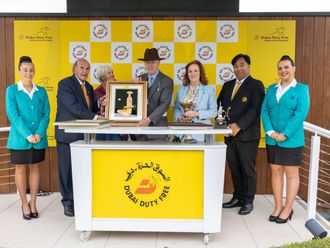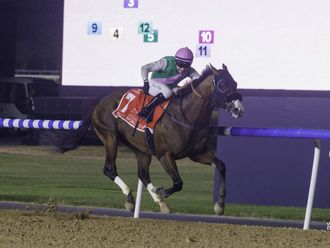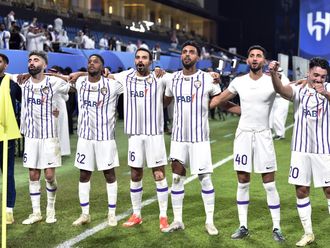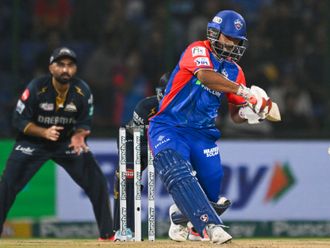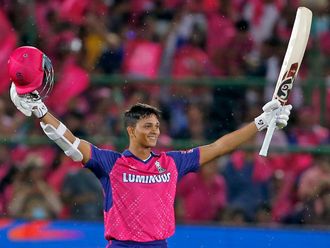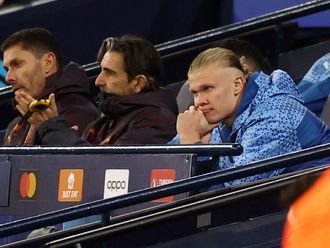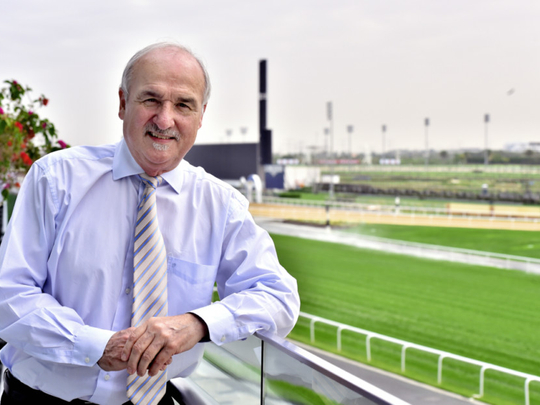
DUBAI: As the official handicapper for the Emirates Racing Authority (ERA), Melvin Day is among the handful of people who have been witness to the big Dubai World Cup night since its inception in 1996. From that first race that was won by the legendary Cigar until date, Day has witnessed it all as he tells Gulf News. Excerpts:
What exactly is handicapping? Is it an art?
Handicapping is like ranking in tennis or the handicap system followed in golf. The main idea is to have a level playing field. The job of the handicapper is to give all the horses an equal chance in the race. He does this by adjusting the weights. Scientifically, there is the theory that the weight is of utmost importance to the race.
A handicap race in horse racing is a race in which horses carry different weights, allocated by the handicapper. Quite simply, a better horse will carry a heavier weight, to give it a disadvantage when racing against slower horses. So it is like creating a level playing field basically to give each of these challengers a chance to win the race.
There is just half a point separating all these horses. So if they do run according to form then we are going to get a very exciting race. What else you need to take into account here is where the horses are drawn, who is going to make the running, how the horse is feeling on that day and also how the track is playing. Is it favouring the horses with the low numbers.
There will be a lot of other smaller factors that will also come into play. Then the other thing that will affect the race is the actual distance over which the race is run. A four-year-old horse over a mile and a half will be getting a kilogram from an older horse, and again the fillies and the mares will be getting their 2kg allowance. So when you look at that racecard, lets say in the Godolphin Mile, there are only four points between the ten or 12 horses in the field. So on paper it looks to be an exciting race.
What is a perfect race in the eyes of a handicapper?
As a handicapper, we are going away from the Dubai World Cup. A perfect race is really a very, very close finish. Obviously handicappers would like to have a ‘dead heat’. But it’s almost impossible nowadays due to photo-finish technology and we get very few dead heats now.
Obviously as a handicapper you want to see all the horses competitive. You want to see them all together competing and in contention with just over 200 metres to go. That makes it exciting racing and a very close finish by a head, a short head, nose and neck.
As long as you’ve got a competitive race, what you don’t want is for horses to win by three or four lengths and then another is five lengths behind and the other one another three lengths behind. That is not a good result for a handicapper.
How did you get into being a handicapper?
When I was young, I started playing football. But I soon realised I was not going to be the next George Best. But I used to watch a lot of racing on television in black and white on a Saturday afternoon. There was a very famous broadcaster called Sir Peter O’Sullevan (who died last July).
This was sometime in the 1960s when The Beatles were famous and I slowly got into the rating of horses, which was in fact unusual in those days.
When I was about 21 I went to work in a magazine and then I also did some freelance till I got a proper job. I worked on a newspaper called The Sporting Chronicle and that’s when I started doing a rating column as sub-editor there. I started writing a column on two-year-olds and rating the horses at the same time.
From that it grew and when that newspaper closed, The Racing Post founded by His Highness Shaikh Mohammad Bin Rashid Al Maktoum, Vice President and Prime Minister of the UAE and Ruler of Dubai started about three years later (1986) and I got a phone call asking me if I would work them and do the thoroughbred ratings for them, which I did. I did this for nine years and then I got another phone call asking me if I would be interested in moving to Dubai as a handicapper.
That was in 1994 and the first Dubai World Cup was not until 1996. But I was told the ratings had to be done. There were some good horses here and it was difficult to gauge them because there was no international racing, except for a Jockeys Challenge when I came here first. The Dubai World Cup wasn’t what it is now. So we made the start. It is great being involved from the beginning. And then of course the concept of the Carnival came in much later and that has been a big boost for us.
What’s your best result of a closest finish in a World Cup?
I would always look into a World Cup for more spectacular wins. You want the best horse to win. My memories of the World Cup would be Cigar winning the first World Cup in 1996. That was a great final furlong battle. Dubai Millennium had a spectacular win coming away to win by six lengths in classic fashion. It is just so gratifying to see a good horse do that. At the local level too we’ve had some really good finishes too.
What would you do to have uniform standards in handicapping internationally?
First of all the ratings are called the international classifications. The first meeting was between five European countries in 1976. And it is now expanded and truly global. The Americans did become involved quite early on. We now meet in Hong Kong every year as we are a member of the Asian Racing Federation. Usually we have a meeting in July or August.
As handicappers we have to propose ratings for all our horses, who need to be rated 115 and above that are running in our races. So we are constantly monitoring each others’ work. The standard is set and every year we meet and discuss and vote on what rating a horse should be. For instance, last year American Pharaoh, who was the Triple Crown winner had a high rating of 134. And the best one before that obviously was Frankel from England who got a 141 that hadn’t been achieved since 1986. These are horses that come like almost once in a lifetime. I have been lucky to see some of the best horses. Like Dancing Brave (1986) and Frankel.
Now we’ve got South America come into the fold some three years ago. They have five countries and they sent in a representation from their region. Then from North America we have USA and Canada and then in Europe we have Germany, France, Italy, Ireland and Great Britain. Then other countries such as South Africa, Australia, New Zealand, Japan and Hong Kong are the other members that meet.
We have to justify our ratings to each other now. Also something like the Asian Racing Federation we also have to submit our ratings here, not only for the big races but also for the Group 2 and Group 3 races.
The best races, we have a couple of good Group 2 races on Dubai World Cup night, Godolphin Mile and the Dubai Gold Cup along with the Group 1 races. There is not a lot between the runners. And as long as there is something in the 115 range then it is always going to be a strong race.
There are nine races on Dubai World Cup night. Can you see a tenth? Or the event held over two days?
That is not up to me at all. I think the Breeders Cup tried something like this in the USA a few years and I think it sort of diluted the whole event. I wouldn’t be in favour of adding another race and then having it over two days. On the other hand, there have been a lot of people of the opinion that we should perhaps add a seven-furlong race. I agree to this.
What are your expectations from the Dubai World Cup this year?
I think it will be a very good World Cup. We’ve got California Chrome come back from last year. Along with him we have been able to bring in at least three of the best American dirt horses here.
I think we’ve got the best ever available to compete this time. From Hong Kong there is a horse who best run has been in the Maktoum Challenge. Then we have the Japanese horse (Hokko Tarumae), Hoppertunity from America, Intilaaq, Mubtaahij, Mshawish from America. These are all good horses. These are tough horses and all rated above 115. So we can expect one of the best World Cups ever.
Where would you like to see the Dubai World Cup?
We have come a long, long way since the first race was held in 1996. I would like for us to obviously continue improving all the time.
We want to have the best of the best horses from around the world.As long as we continue to do that, or we can do that, then we will keep on growing. It actually depends on what horses are available that year.



